2022 TOYOTA SIENNA HYBRID warning
[x] Cancel search: warningPage 474 of 600
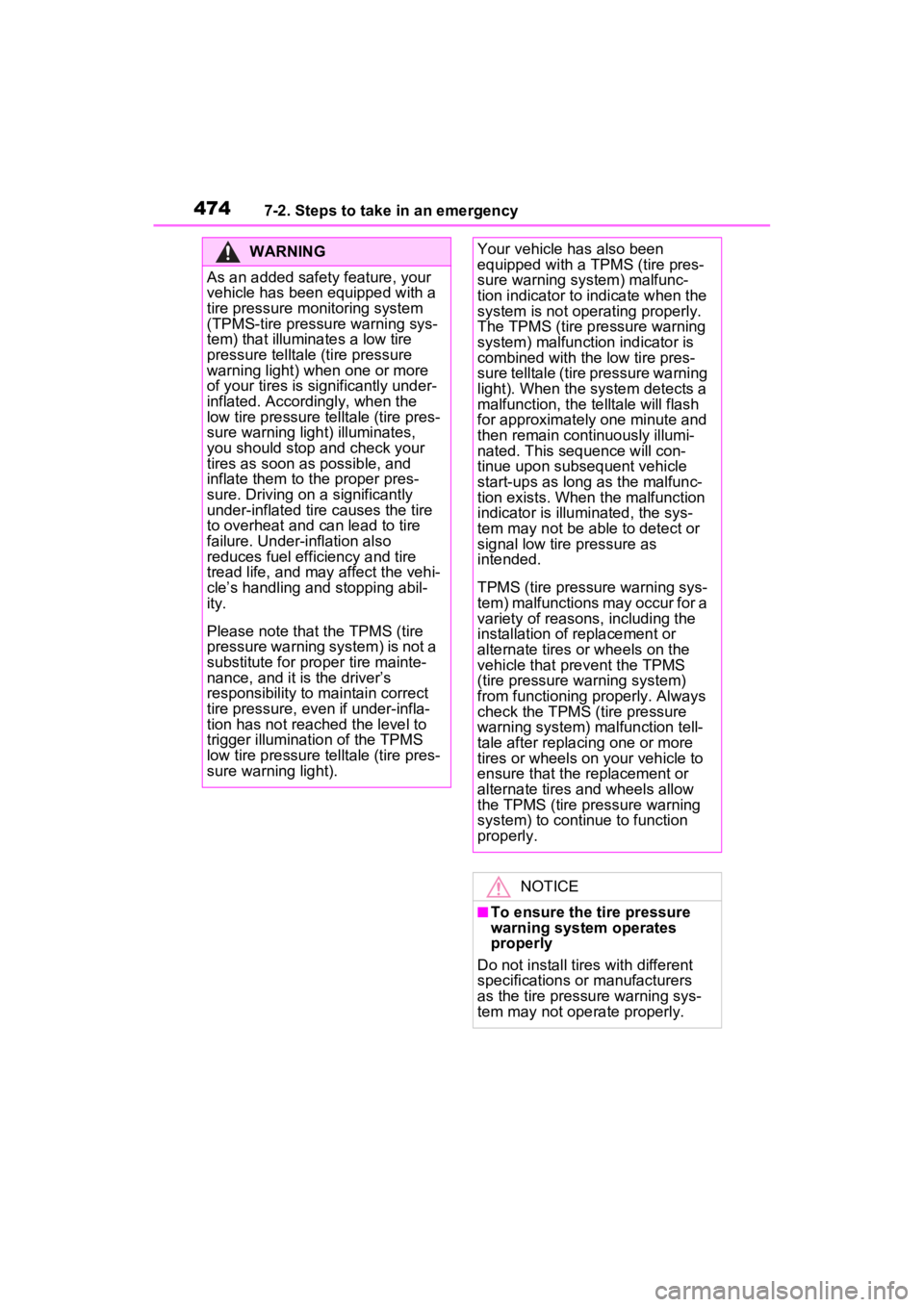
4747-2. Steps to take in an emergency
WARNING
As an added safety feature, your
vehicle has been equipped with a
tire pressure m onitoring system
(TPMS-tire pressure warning sys-
tem) that illuminates a low tire
pressure telltale (tire pressure
warning light) when one or more
of your tires is significantly under-
inflated. Accordingly, when the
low tire pressure telltale (tire pres-
sure warning light) illuminates,
you should stop and check your
tires as soon as possible, and
inflate them to the proper pres-
sure. Driving on a significantly
under-inflated tire causes the tire
to overheat and can lead to tire
failure. Under-inflation also
reduces fuel efficiency and tire
tread life, and may affect the vehi-
cle’s handling and stopping abil-
ity.
Please note that the TPMS (tire
pressure warning system) is not a
substitute for pro per tire mainte-
nance, and it is the driver’s
responsibility to maintain correct
tire pressure, even if under-infla-
tion has not reach ed the level to
trigger illumination of the TPMS
low tire pressure telltale (tire pres-
sure warning light).
Your vehicle has also been
equipped with a TPMS (tire pres-
sure warning system) malfunc-
tion indicator to indicate when the
system is not operating properly.
The TPMS (tire pressure warning
system) malfunction indicator is
combined with the low tire pres-
sure telltale (tire pressure warning
light). When the system detects a
malfunction, the te lltale will flash
for approximately one minute and
then remain continuously illumi-
nated. This sequence will con-
tinue upon subsequent vehicle
start-ups as long as the malfunc-
tion exists. When the malfunction
indicator is illuminated, the sys-
tem may not be ab le to detect or
signal low tire pressure as
intended.
TPMS (tire pressure warning sys-
tem) malfunctions may occur for a
variety of reasons, including the
installation of replacement or
alternate tires or wheels on the
vehicle that prevent the TPMS
(tire pressure warning system)
from functioning properly. Always
check the TPMS (tire pressure
warning system) malfunction tell-
tale after replacing one or more
tires or wheels on your vehicle to
ensure that the replacement or
alternate tires and wheels allow
the TPMS (tire pressure warning
system) to continue to function
properly.
NOTICE
■To ensure the tire pressure
warning system operates
properly
Do not install tires with different
specifications or manufacturers
as the tire pressure warning sys-
tem may not operate properly.
Page 475 of 600
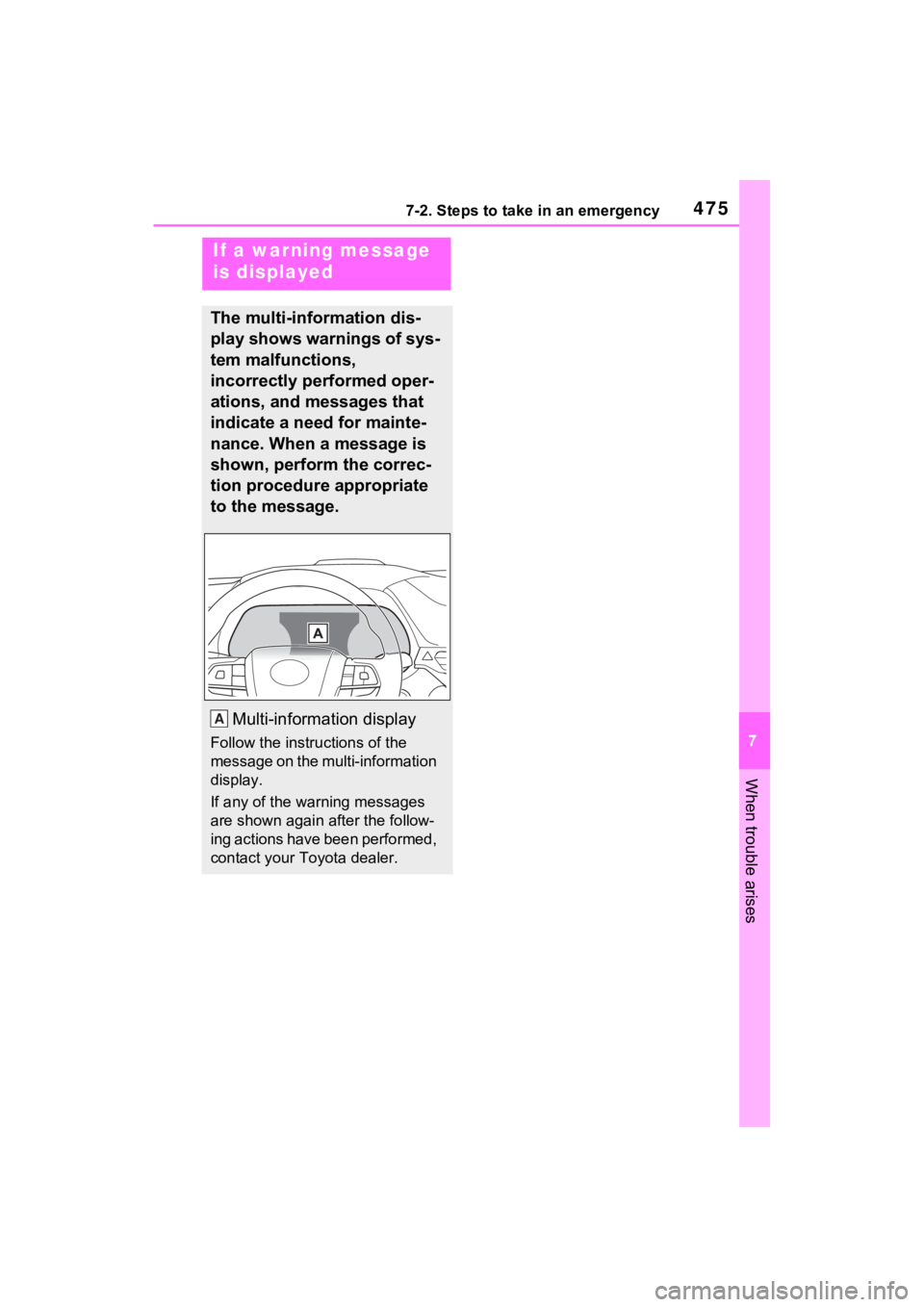
4757-2. Steps to take in an emergency
7
When trouble arises
If a warning message
is displayed
The multi-information dis-
play shows warnings of sys-
tem malfunctions,
incorrectly performed oper-
ations, and messages that
indicate a need for mainte-
nance. When a message is
shown, perform the correc-
tion procedure appropriate
to the message.
Multi-information display
Follow the instructions of the
message on the multi-information
display.
If any of the warning messages
are shown again after the follow-
ing actions have been performed,
contact your To yota dealer.
A
Page 476 of 600
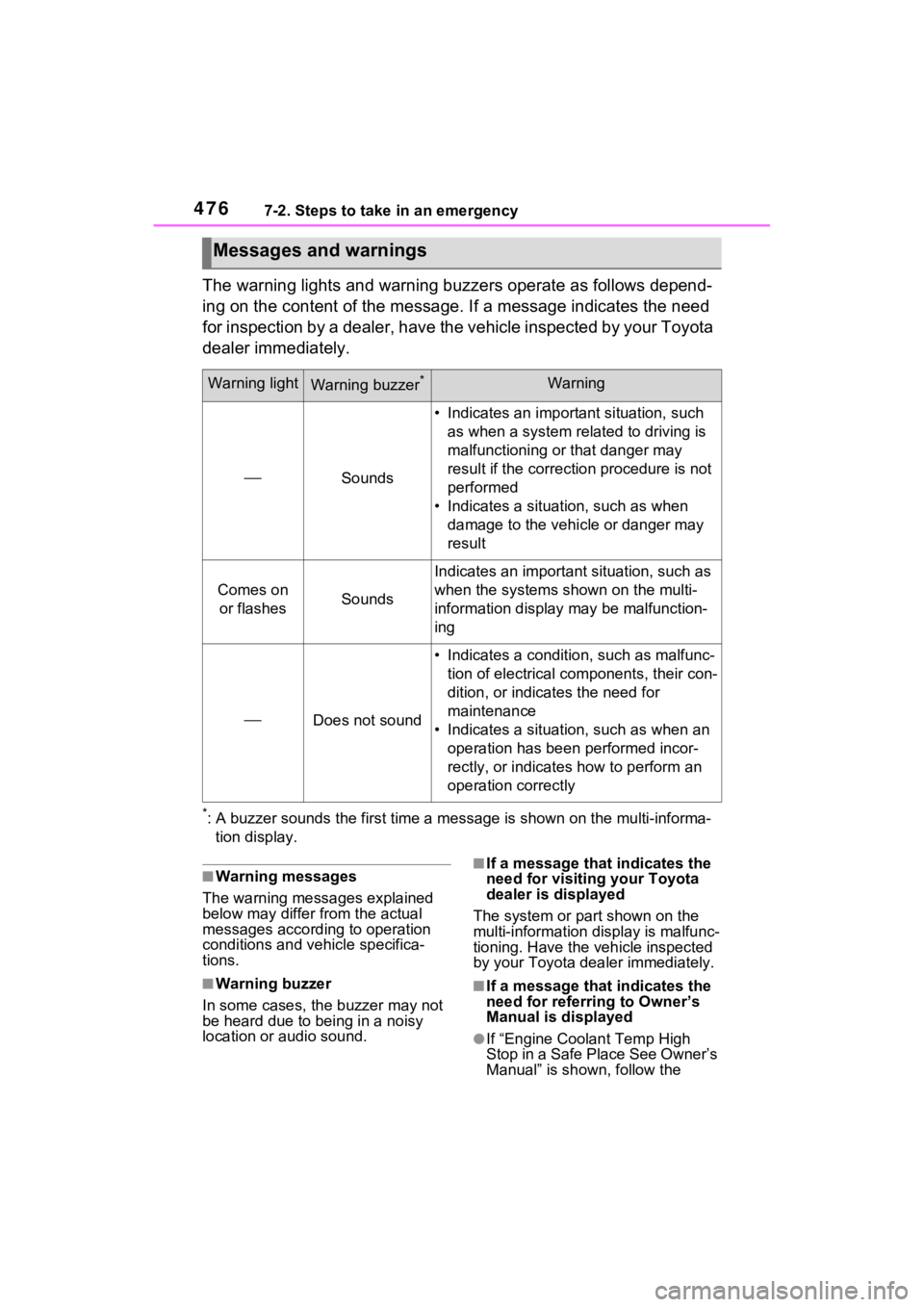
4767-2. Steps to take in an emergency
The warning lights and warning buzzers operate as follows depend-
ing on the content of the message. If a message indicates the need
for inspection by a dealer, have the vehicle inspected by your Toyota
dealer immediately.
*: A buzzer sounds the first time a message is show n on the multi-informa-
tion display.
■Warning messages
The warning messages explained
below may differ from the actual
messages according to operation
conditions and vehicle specifica-
tions.
■Warning buzzer
In some cases, the buzzer may not
be heard due to being in a noisy
location or audio sound.
■If a message that indicates the
need for visiting your Toyota
dealer is displayed
The system or part shown on the
multi-information di splay is malfunc-
tioning. Have the vehicle inspected
by your Toyota dea ler immediately.
■If a message that indicates the
need for referring to Owner’s
Manual is displayed
●If “Engine Coolant Temp High
Stop in a Safe Place See Owner’s
Manual” is shown, follow the
Messages and warnings
Warning lightWarning buzzer*Warning
Sounds
• Indicates an import ant situation, such
as when a system related to driving is
malfunctioning or that danger may
result if the correction procedure is not
performed
• Indicates a situat ion, such as when
damage to the vehicle or danger may
result
Comes on or flashesSounds
Indicates an importan t situation, such as
when the systems shown on the multi-
information display may be malfunction-
ing
Does not sound
• Indicates a condition, such as malfunc- tion of electrical components, their con-
dition, or indicat es the need for
maintenance
• Indicates a situatio n, such as when an
operation has been performed incor-
rectly, or indicates how to perform an
operation correctly
Page 477 of 600
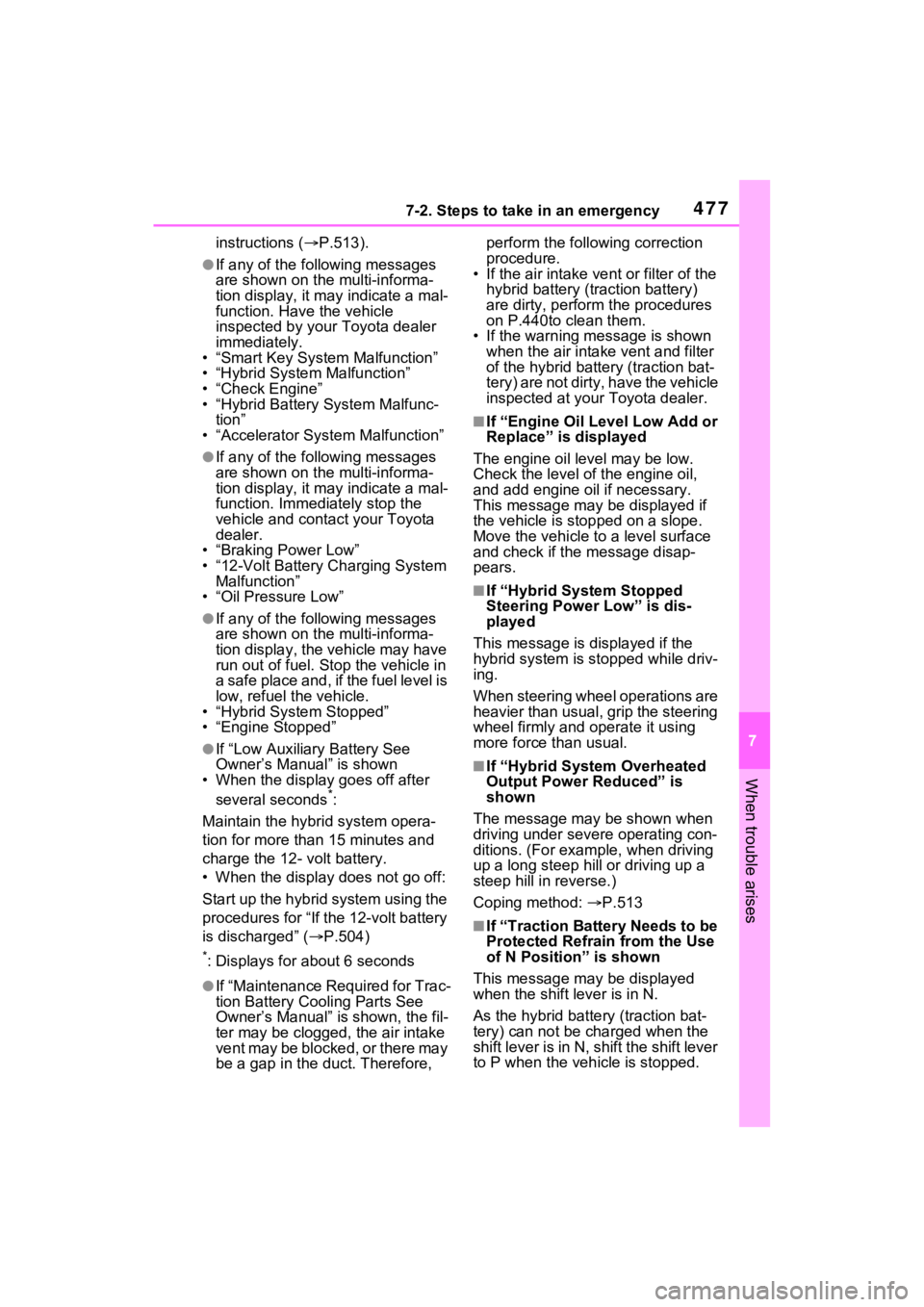
4777-2. Steps to take in an emergency
7
When trouble arises
instructions (P.513).
●If any of the following messages
are shown on the multi-informa-
tion display, it may indicate a mal-
function. Have the vehicle
inspected by your Toyota dealer
immediately.
• “Smart Key System Malfunction”
• “Hybrid System Malfunction”
• “Check Engine”
• “Hybrid Battery System Malfunc-
tion”
• “Accelerator Syst em Malfunction”
●If any of the following messages
are shown on the multi-informa-
tion display, it may indicate a mal-
function. Immediately stop the
vehicle and contact your Toyota
dealer.
•“Braking Power Low”
• “12-Volt Battery Charging System Malfunction”
• “Oil Pressure Low”
●If any of the following messages
are shown on the multi-informa-
tion display, the vehicle may have
run out of fuel. Stop the vehicle in
a safe place and, if the fuel level is
low, refuel the vehicle.
• “Hybrid System Stopped”
• “Engine Stopped”
●If “Low Auxiliary Battery See
Owner’s Manual” is shown
• When the display goes off after
several seconds
*:
Maintain the hybri d system opera-
tion for more than 15 minutes and
charge the 12- volt battery.
• When the display does not go off:
Start up the hybrid system using the
procedures for “If the 12-volt battery
is discharged” ( P.504)
*: Displays for about 6 seconds
●If “Maintenance Required for Trac-
tion Battery Cooling Parts See
Owner’s Manual” is shown, the fil-
ter may be clogged, the air intake
vent may be blocked, or there may
be a gap in the duct. Therefore, perform the follo
wing correction
procedure.
• If the air intake vent or filter of the
hybrid battery (traction battery)
are dirty, perform the procedures
on P.440to clean them.
• If the warning message is shown when the air intake vent and filter
of the hybrid battery (traction bat-
tery) are not dirty, have the vehicle
inspected at you r Toyota dealer.
■If “Engine Oil Level Low Add or
Replace” is displayed
The engine oil level may be low.
Check the level o f the engine oil,
and add engine oil if necessary.
This message may be displayed if
the vehicle is stopped on a slope.
Move the vehicle to a level surface
and check if the message disap-
pears.
■If “Hybrid System Stopped
Steering Power Low” is dis-
played
This message is displayed if the
hybrid system is stopped while driv-
ing.
When steering wheel operations are
heavier than usual, grip the steering
wheel firmly and operate it using
more force than usual.
■If “Hybrid System Overheated
Output Power Reduced” is
shown
The message may be shown when
driving under severe operating con-
ditions. (For example, when driving
up a long steep hill or driving up a
steep hill in reverse.)
Coping method: P.513
■If “Traction Battery Needs to be
Protected Refrain from the Use
of N Position” is shown
This message may be displayed
when the shift lever is in N.
As the hybrid battery (traction bat-
tery) can not be charged when the
shift lever is in N, shift the shift lever
to P when the vehicle is stopped.
Page 479 of 600
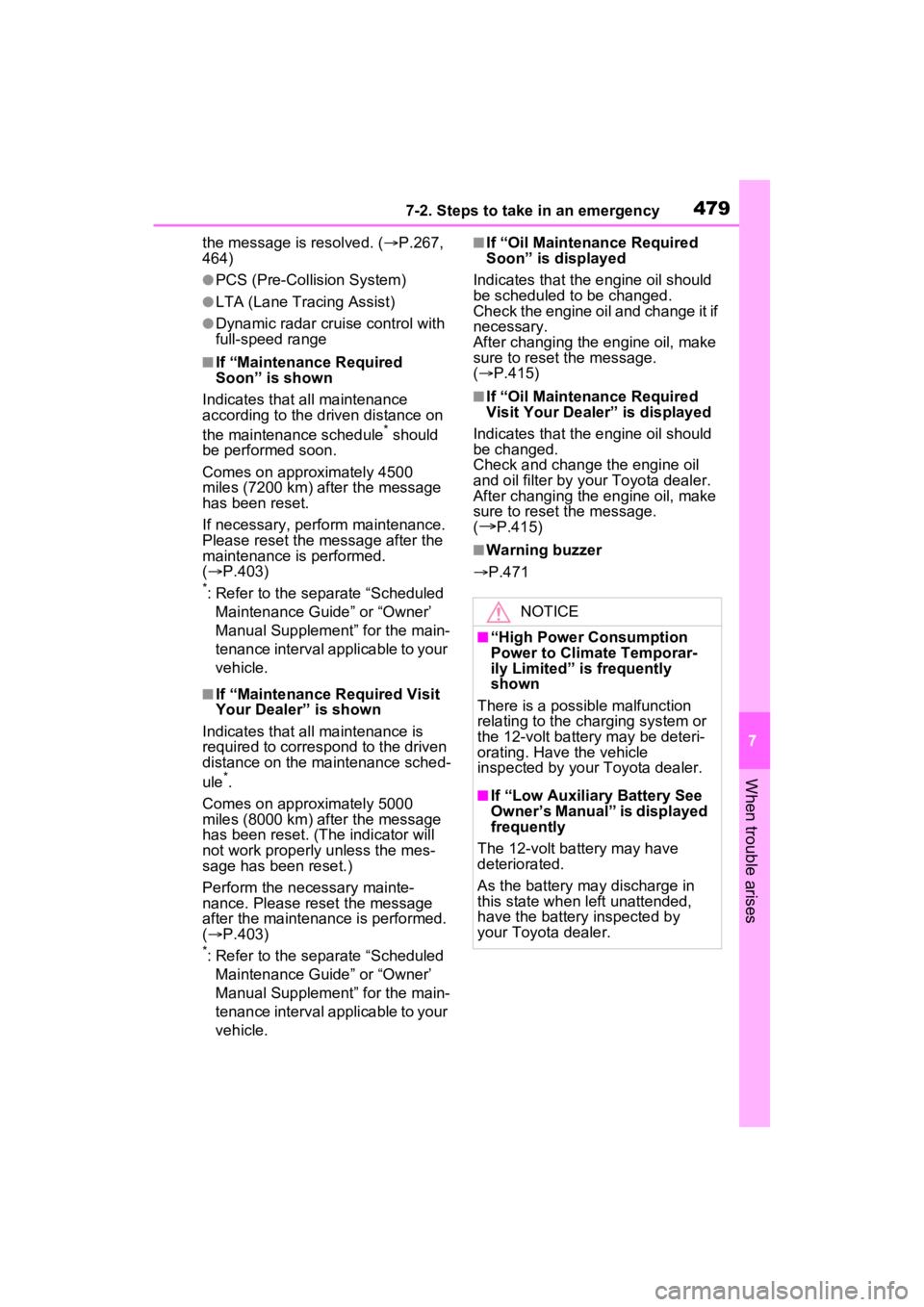
4797-2. Steps to take in an emergency
7
When trouble arises
the message is resolved. ( P.267,
464)
●PCS (Pre-Collis ion System)
●LTA (Lane Tracing Assist)
●Dynamic radar cruise control with
full-speed range
■If “Maintenance Required
Soon” is shown
Indicates that all maintenance
according to the driven distance on
the maintenance schedule
* should
be performed soon.
Comes on approximately 4500
miles (7200 km) after the message
has been reset.
If necessary, perform maintenance.
Please reset the message after the
maintenance is performed.
( P.403)
*: Refer to the separate “Scheduled
Maintenance Guide” or “Owner’
Manual Supplement” for the main-
tenance interval applicable to your
vehicle.
■If “Maintenance Required Visit
Your Dealer” is shown
Indicates that all maintenance is
required to correspond to the driven
distance on the maintenance sched-
ule
*.
Comes on approximately 5000
miles (8000 km) after the message
has been reset. (The indicator will
not work properly unless the mes-
sage has been reset.)
Perform the necessary mainte-
nance. Please reset the message
after the maintenance is performed.
( P.403)
*: Refer to the separate “Scheduled
Maintenance Guide” or “Owner’
Manual Supplement” for the main-
tenance interval applicable to your
vehicle.
■If “Oil Maintenance Required
Soon” is displayed
Indicates that the engine oil should
be scheduled to be changed.
Check the engine oil and change it if
necessary.
After changing the engine oil, make
sure to reset t he message.
( P.415)
■If “Oil Maintenance Required
Visit Your Dealer” is displayed
Indicates that the engine oil should
be changed.
Check and change the engine oil
and oil filter by yo ur Toyota dealer.
After changing the engine oil, make
sure to reset t he message.
(
P.415)
■Warning buzzer
P.471
NOTICE
■“High Power Consumption
Power to Climate Temporar-
ily Limited” is frequently
shown
There is a possible malfunction
relating to the charging system or
the 12-volt battery may be deteri-
orating. Have the vehicle
inspected by your Toyota dealer.
■If “Low Auxiliary Battery See
Owner’s Manual” is displayed
frequently
The 12-volt battery may have
deteriorated.
As the battery may discharge in
this state when left unattended,
have the battery inspected by
your Toyota dealer.
Page 480 of 600
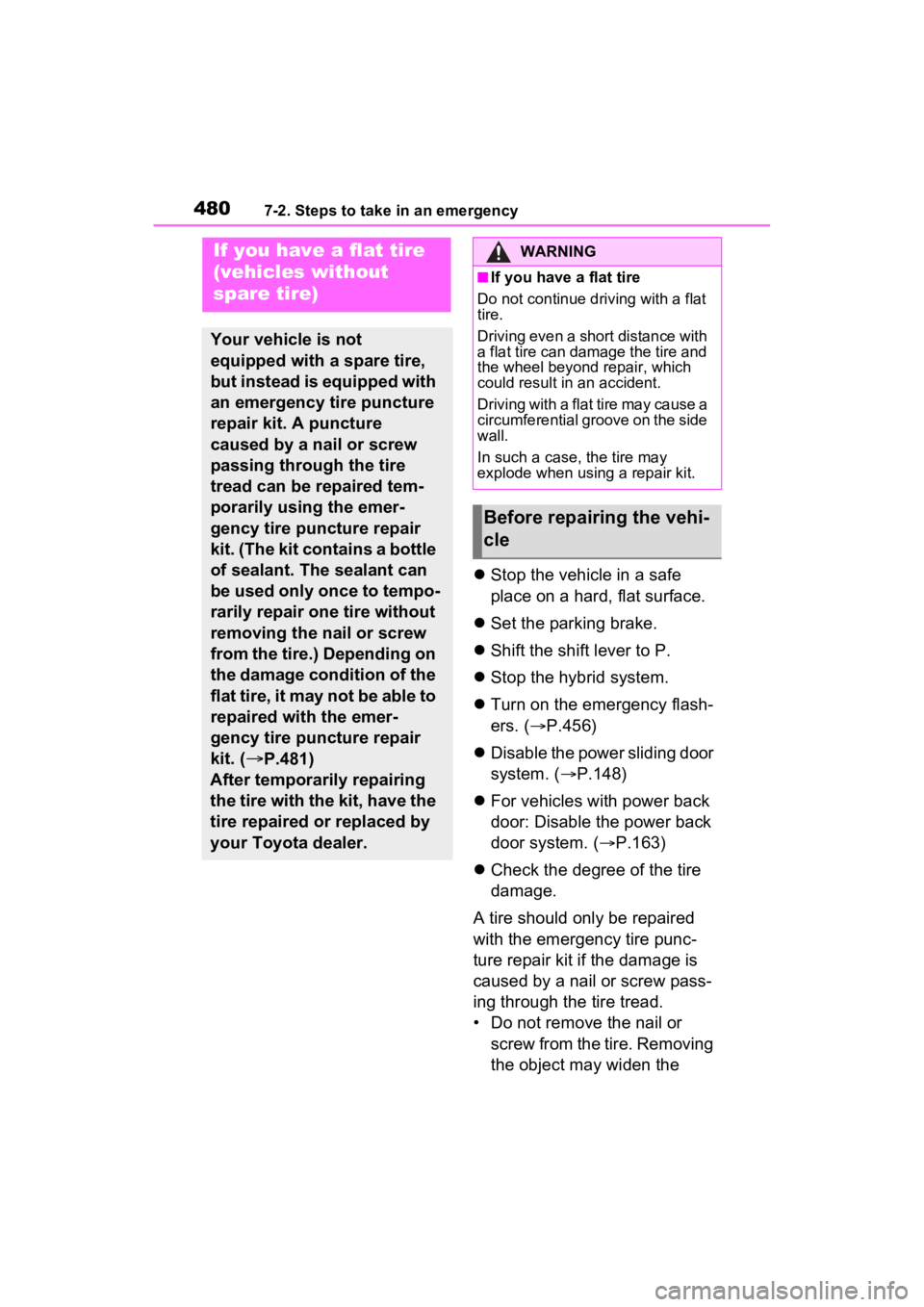
4807-2. Steps to take in an emergency
Stop the vehicle in a safe
place on a hard, flat surface.
Set the parking brake.
Shift the shift lever to P.
Stop the hybrid system.
Turn on the emergency flash-
ers. ( P.456)
Disable the power sliding door
system. ( P.148)
For vehicles with power back
door: Disable the power back
door system. ( P.163)
Check the degree of the tire
damage.
A tire should only be repaired
with the emergency tire punc-
ture repair kit if the damage is
caused by a nail or screw pass-
ing through the tire tread.
• Do not remove the nail or screw from the tire. Removing
the object may widen the
If you have a flat tire
(vehicles without
spare tire)
Your vehicle is not
equipped with a spare tire,
but instead is equipped with
an emergency tire puncture
repair kit. A puncture
caused by a nail or screw
passing through the tire
tread can be repaired tem-
porarily using the emer-
gency tire puncture repair
kit. (The kit contains a bottle
of sealant. The sealant can
be used only once to tempo-
rarily repair one tire without
removing the nail or screw
from the tire.) Depending on
the damage condition of the
flat tire, it may not be able to
repaired with the emer-
gency tire puncture repair
kit. (
P.481)
After temporarily repairing
the tire with the kit, have the
tire repaired or replaced by
your Toyota dealer.
WARNING
■If you have a flat tire
Do not continue driving with a flat
tire.
Driving even a short distance with
a flat tire can damage the tire and
the wheel beyond repair, which
could result in an accident.
Driving with a flat tire may cause a
circumferential groove on the side
wall.
In such a case, the tire may
explode when using a repair kit.
Before repairing the vehi-
cle
Page 481 of 600
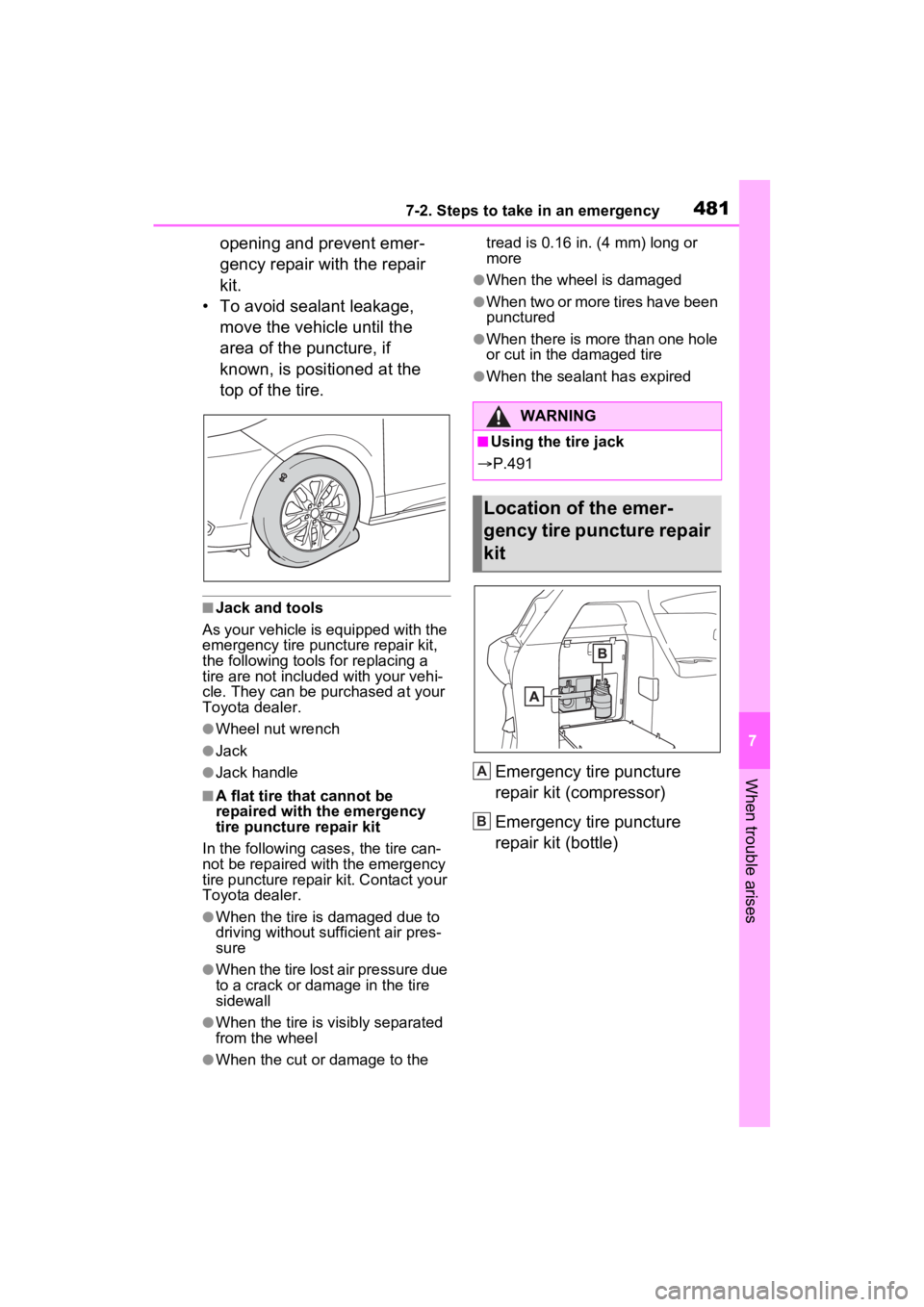
4817-2. Steps to take in an emergency
7
When trouble arises
opening and prevent emer-
gency repair with the repair
kit.
• To avoid sealant leakage, move the vehicle until the
area of the puncture, if
known, is positioned at the
top of the tire.
■Jack and tools
As your vehicle is equipped with the
emergency tire puncture repair kit,
the following tools for replacing a
tire are not inclu ded with your vehi-
cle. They can be purchased at your
Toyota dealer.
●Wheel nut wrench
●Jack
●Jack handle
■A flat tire that cannot be
repaired with t he emergency
tire puncture repair kit
In the following ca ses, the tire can-
not be repaired with the emergency
tire puncture repair kit. Contact your
Toyota dealer.
●When the tire is damaged due to
driving without sufficient air pres-
sure
●When the tire lost air pressure due
to a crack or dam age in the tire
sidewall
●When the tire is visibly separated
from the wheel
●When the cut or damage to the tread is 0.16 in. (4 mm) long or
more
●When the wheel is damaged
●When two or more tires have been
punctured
●When there is more than one hole
or cut in the damaged tire
●When the sealant has expired
Emergency tire puncture
repair kit (compressor)
Emergency tire puncture
repair kit (bottle)
WARNING
■Using the tire jack
P.491
Location of the emer-
gency tire puncture repair
kit
A
B
Page 483 of 600
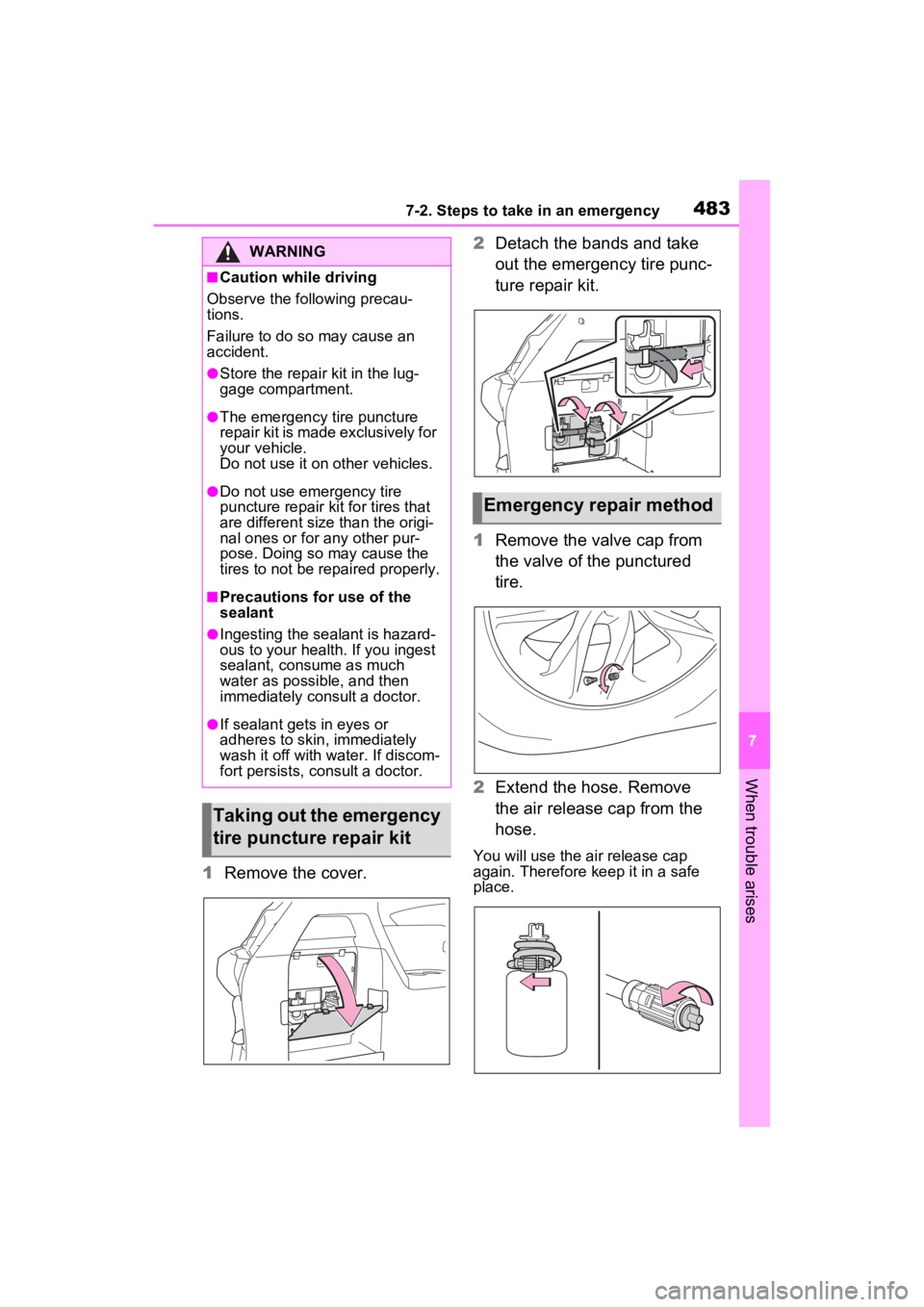
4837-2. Steps to take in an emergency
7
When trouble arises
1Remove the cover. 2
Detach the bands and take
out the emergency tire punc-
ture repair kit.
1 Remove the valve cap from
the valve of the punctured
tire.
2 Extend the hose. Remove
the air release cap from the
hose.
You will use the air release cap
again. Therefore keep it in a safe
place.
WARNING
■Caution while driving
Observe the following precau-
tions.
Failure to do so may cause an
accident.
●Store the repair kit in the lug-
gage compartment.
●The emergency tire puncture
repair kit is made exclusively for
your vehicle.
Do not use it on other vehicles.
●Do not use emergency tire
puncture repair kit for tires that
are different size than the origi-
nal ones or for any other pur-
pose. Doing so may cause the
tires to not be repaired properly.
■Precautions for use of the
sealant
●Ingesting the sealant is hazard-
ous to your health. If you ingest
sealant, consume as much
water as possible, and then
immediately consult a doctor.
●If sealant gets in eyes or
adheres to skin, immediately
wash it off with water. If discom-
fort persists, consult a doctor.
Taking out the emergency
tire puncture repair kit
Emergency repair method